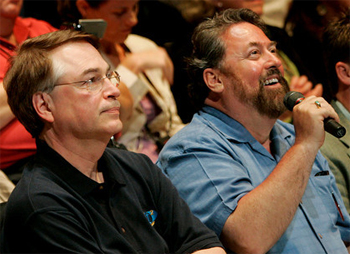
Powerful new “brain-inspired” computing capabilities are turning the scientific method on its head by accelerating a “data science” experimental method that detects patterns in data before generating a hypothesis. “Pattern recognition is a mode of epistemology, a way of knowing,” says CSE Prof. Larry Smarr, director of the California Institute for Telecommunications and Information Technology (Calit2). “It’s taking the same data that’s available to everyone and trying to let the data talk to you instead of putting your preconceived notions onto it.”
 Smarr (far left, with futurist Mark Anderson) is one of the founders of a new Pattern Recognition Laboratory at UC San Diego, housed in Calit2's Qualcomm Institute. According to Smarr, the lab will explore important tradeoffs as machine learning techniques and novel computer architectures continue to develop rapidly. One major challenge is how to optimize a variety of machine-learning algorithms on different architectures and discover which are fastest and most energy efficient for specific applications across a wide range of disciplines. The lab will also explore solutions involving flexibility to process both massive static arrays of data as well as myriad flows of data -- and to find the never-before-seen patterns in both.
Smarr (far left, with futurist Mark Anderson) is one of the founders of a new Pattern Recognition Laboratory at UC San Diego, housed in Calit2's Qualcomm Institute. According to Smarr, the lab will explore important tradeoffs as machine learning techniques and novel computer architectures continue to develop rapidly. One major challenge is how to optimize a variety of machine-learning algorithms on different architectures and discover which are fastest and most energy efficient for specific applications across a wide range of disciplines. The lab will also explore solutions involving flexibility to process both massive static arrays of data as well as myriad flows of data -- and to find the never-before-seen patterns in both.
Under its first director, ECE Prof. Ken Kreutz-Delgado, the Pattern Recognition Lab is in the early stages of building a 'garden of architectures' capable of performing massive amounts of high-speed processing without consuming as much power as traditional chips. The architectures include both traditional von Neumann computing architectures such as graphics processing units (GPUs), as well as non-von Neumann architectures including high-density FPGAs, IBM's TrueNorth neuromorphic processor, and KnuEdge's LambdaFabricTM neural computing sytems.
The Pattern Recognition Lab grew out of discussions between CSE's Smarr and futurist Mark Anderson, creator of the Future in Review (FiRe) conference series (whose 2016 meeting got underway on Sept. 27). Anderson sits on the Callit2 Advisory Board, while Smarr is a member of the FiRe Advisory Board.
Read the Calit2 news release announcing the Pattern Recognition Laboratory.

